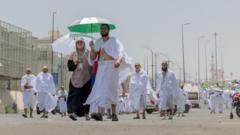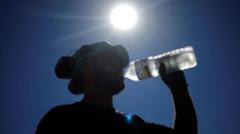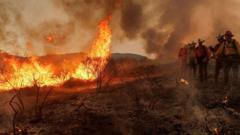As the annual Hajj pilgrimage commences in the Saudi holy city of Mecca, authorities are taking unprecedented measures to protect over 1.4 million Muslims from extreme heat conditions. This initiative follows last year's catastrophic event, where approximately 1,300 pilgrims, mostly unregistered, succumbed to soaring temperatures.
With forecasts predicting temperatures could rise to a sweltering 44°C (111°F), Saudi authorities have laid out specific guidelines designed to ensure the safety and wellbeing of the attendees. These guidelines emphasize the importance of seeking shade, avoiding sun exposure from 10:00 AM to 4:00 PM, and staying hydrated.
To combat the heat, the government has launched several initiatives, including the planting of thousands of trees and the installation of over 400 cooling units, reportedly making the Grand Mosque's cooling system the largest worldwide. Additionally, authorities have expanded shaded areas by 50,000 square meters to provide respite from the scorching sun.
Significantly, registration has become mandatory for pilgrims wishing to attend Hajj, as it offers access to necessary amenities such as transportation and air-conditioned accommodation. The government has issued strict penalties for unregistered pilgrims, including a hefty fine of $5,000 and a potential 10-year ban from reentry into the Kingdom. As of the latest reports, officials have prevented over 269,000 individuals from entering Mecca due to a lack of registration.
During the opening days of Hajj, male pilgrims don traditional white garments known as Ihram, while women wear modest attire, revealing only their faces. Pilgrims perform sacred rituals, including circling the Kaaba and walking between the hills of Safa and Marwa, before proceeding to Mina where they will spend the night in tent cities.
Health officials reiterate the necessity for pilgrims to adhere to the safety protocols established to mitigate the risk of heat exhaustion and related health issues. Moreover, the pilgrimage serves as an essential part of Islamic faith, compelling every adult Muslim who can afford it and is physically able to undertake the journey at least once in their lives.
In the shadow of past tragedies, including a deadly stampede in Mina in 2015, Saudi Arabia is working tirelessly to cultivate a safe environment for the thousands of faithful participating in this essential religious observance.




















